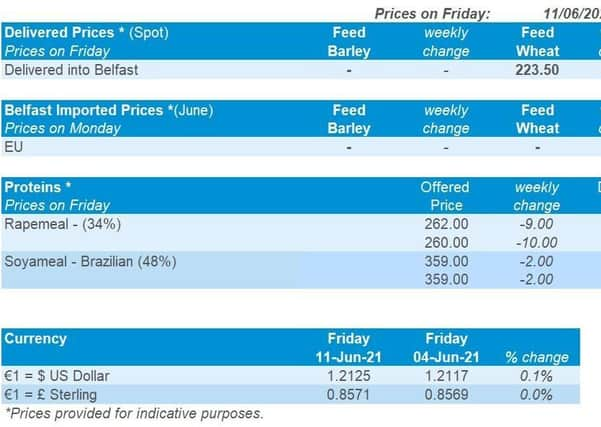Northern Ireland Weekly Market Report


14 June 2021
Grains
Wheat
Global 2021/22 supply looks ample, with rising production forecasts for the EU, Russia the Black Sea, and US. US dry weather continues to cause supply concerns, though not yet quantified.
Maize
June’s WASDE brought little change to the 2021/22 supply and demand balance, with strong Chinese demand for coarse grains. US weather remains a key factor driving supply concern.
Barley
Advertisement
Advertisement
Barley prices could not be published this week due to data validation. Going forward, barley prices are expected to follow the direction of other feed grain prices, especially maize.
Global markets
Global grain movements were mixed last week. Chicago maize futures (Dec 21) gained $7.19/t on the week, to close at $240.06/t on Friday. Conversely, global wheat futures took small falls on the week for both the Paris and Chicago contracts, on new-crop supply rises.
The latest WASDE boasted no surprises to the grain markets, as James discussed on Friday. For 2020/21 maize, Brazilian production was reduced 3.5Mt to 98.5Mt. US demand was increased for 2020/21 on account of bioethanol demand. That said, suggestions that refiners may be granted relief from the biofuel blending requirements cooled values. 2021/22 global maize production was left unchanged for now. Global wheat production was raised 5.5Mt to 794.4Mt due to increases in crop size in the EU, US, Russia, and Ukraine.
The Conab report on old-crop Brazilian maize production failed to stimulate strength, cutting production by 10.0Mt to 96.4Mt. This is below the USDA’s revised figure, but above current trade estimations. Buenos Aires Grains Exchange increased Argentina’s 2020/21 maize production 2.0Mt to 48.0Mt last week (WASDE remained at 47Mt).
Advertisement
Advertisement
Arguably, despite other news, maize markets found support through dry US weather. This week, the outlook for the Midwest looks cooler, but some areas remain in extreme drought.
In Europe, 2021/22 grain production was increased by Stratégie Grains last week, with rises also reflected in the June WASDE. Gains were made to soft wheat (+1.5Mt), barley (+0.2Mt) and maize (+0.1Mt) on favourable late spring weather conditions. Europe’s wheat harvest is expected to be late, but large.
Russia’s agricultural consultancy SovEcon raised their wheat production forecasted 1.5Mt to 82.4Mt on Friday due to improved weather and crop condition, although below the USDA’s 86Mt forecast.
UK focus
UK feed wheat futures (Nov-21) closed at £175.00/t on Friday, down £2.10/t on the week. UK futures were led by global wheat contracts last week, falling on increased supply forecasts.
Advertisement
Advertisement
The UK’s new crop wheat production was pegged last week by the WASDE as 14.1Mt. Meanwhile, Stratégie Grains forecast UK soft wheat production at 14.8Mt for 2021/22.
Following futures markets, delivered values were also knocked back for both old-crop and new-crop. Feed wheat into East Anglia (Nov-21) was quoted £2.50/t down, to £175.00/t (Thurs-Thurs), £0.50/t below the Nov-21 futures. Group 1 milling into North West (Nov-21) fell £2.00/t, to £208.00/t (Thurs-Thurs). No feed barley prices have been quoted this week due to data validation.
The latest daily futures settlement prices are available on our website.
Oilseeds
Rapeseed
The supply and demand for rapeseed remains tight, and weather between now and harvest will be key for forward price direction. Canadian growing regions currently look dry.
Soyabeans
Advertisement
Advertisement
While stocks position eased in the latest USDA report, oilseed markets remain tight. US biofuel policy will be a key watch point for markets going forward, as will US crop conditions.
Global markets
Global oilseed markets were under pressure last week, despite small gains in Chicago soyabeans (Nov-21), as support for vegetable oils waned. The value of Chicago soyabean oil (Dec-21) dropped $13.01/t, to $1404.55/t, Friday-Friday. Soya oil has been an increasingly large contributor to the price movements of soyabeans and so the oilseed complex in recent months.
Weakness in soya oil and soyabeans followed a somewhat bearish outlook for 2021/22 oilseeds in the latest USDA supply and demand estimates (WASDE), released last Thursday. Global supply of oilseeds is expected to increase by 1.96Mt, to 734.40Mt. As a result, global oilseed stocks are seen at 106.30Mt, up 1.66mt on the month. The increases in supply were largely driven by an upward revision to soyabean opening stocks.
One key source of pressure for the US soya oil market has been concerns over demand from the biofuel sector. The high value of renewable fuel credits (RINS), combined with the high value of vegetable oils is heaping financial pressure onto biofuel blenders in the US. Any policy changes which ease blending mandates in the biofuel sector in the US will likely add further pressure to soyabeans (Refinitiv).
Advertisement
Advertisement
Palm oil followed the wider vegetable oil complex lower, although a recovery in buying from India will have been welcome news.
Looking ahead, as well as policy and demand, weather will continue to be key. This is particularly true for the US crop. Rain has been lacking in some key states, and tonight’s crop condition report from the USDA will be watched closely.
Rapeseed focus
Rapeseed prices followed the direction of the wider oilseed complex last week. Paris rapeseed futures (Nov-21) fell by €19.25/t, to close at €511.75/t. UK delivered rapeseed (Erith, Nov-21) followed a similar trend, down £11.00/t Friday-Friday, at £456.50/t.
Pressure from the vegetable oil complex outweighed what continues to be a tight market. That said, Thursday’s USDA report did make upward revisions to EU rapeseed, to 17.2Mt (+600Kt), and Australian rapeseed (+200Kt).
Advertisement
Advertisement
Another region that will be watched closely is Canada. Canadian rapeseed is currently being planted, however, a crop progress report from Statistics Canada last week suggested that crop conditions are broadly average to lower than the 1987-2020 average. Key regions in Canada remain dry.